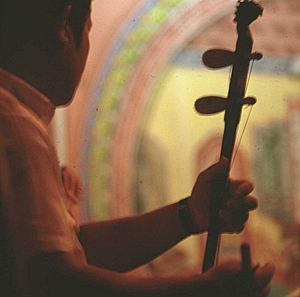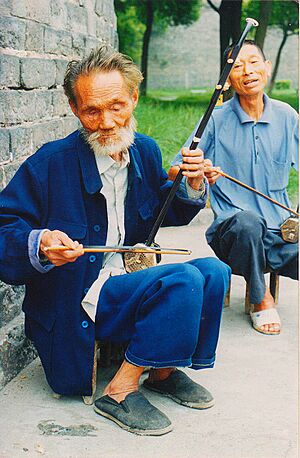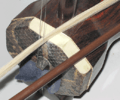Erhu facts for kids
The erhu (pronounced "are-hoo") is a special two-stringed musical instrument played with a bow. Some people call it a "southern fiddle" or even a "Chinese violin." It's used in many ways: by itself, in small groups, and in large orchestras. The erhu is the most popular instrument in the huqin family, which includes many bowed string instruments from China. You can hear the erhu in traditional Chinese music, but also in modern styles like pop, rock, and jazz!
Contents
Erhu Music: Sounds and Styles
The erhu has a beautiful sound that can be used in many different types of music.
Famous Erhu Composers and Songs
A very important composer for the erhu was Liu Tianhua (1895–1932). He was a Chinese musician who also learned about Western music. He wrote many exercises and 10 solo pieces that helped the erhu become a popular instrument for solo performances. Some of his famous pieces include Yue Ye (Moon Night) and Zhu ying Yao hong (Shadows of Candles Flickering Red).
Other well-known erhu songs include:
- Er Quan Ying Yue (Two Springs Reflecting the Moon) by Abing
- Sai Ma (Horse Race) by Huang Haihuai
- Henan Xiaoqu (Henan Folk Tune) by Liu Mingyuan
- Sanmenxia Changxiangqu (Sanmen Gorge Capriccio) by Liu Wenjin
Many of these solo songs are often played with a yangqin (a Chinese hammered dulcimer) as accompaniment. However, some, like Liu Tianhua's pieces, were originally meant to be played without any other instruments.
Erhu in Different Music Groups
Besides being a solo instrument, the erhu is a key part of many music groups. It's used in regional music styles like Jiangnan sizhu, in Chinese opera ensembles, and in modern large Chinese orchestras.
The Erhu in Pop Culture
The erhu has also made its way into many modern performances and soundtracks:
- You can hear the erhu in the Cirque du Soleil show O.
- It's featured in solo performances during some Shen Yun tours.
- Some fusion progressive rock bands, like The Hsu-nami, use the erhu as their main instrument.
- The Taiwanese black metal band ChthoniC also includes the erhu in their music.
- The song "Field Below" by Regina Spektor features the erhu.
- It has appeared in TV series soundtracks like Earth: Final Conflict and video games like World of Warcraft: Mists of Pandaria.
- A special erhu solo is part of the music for the Star Trek movie from 2009, especially for scenes related to Vulcans.
- Wedding celebrations in Cambodia often feature the erhu.
- The erhu is listed in the credits for the Doug Anthony All Stars album Icon.
- It's even used in the character songs for China, a character in the anime Axis Powers Hetalia.
How to Play the Erhu
Playing the erhu involves special techniques for both hands.
Tuning the Erhu
The erhu is almost always tuned to an interval called a fifth. The string closest to the player (the "inside" string) is usually tuned to D4. The string further away (the "outside" string) is tuned to A4. This is the same as the two middle strings on a violin.
Holding the Erhu
Traditionally, the erhu is played while sitting down. The sound box rests on the top of the player's left thigh, and the long neck of the instrument is held straight up. However, some modern performers now play standing up, using a special belt-clip to hold the instrument.
Right Hand Technique
The bow is held with an underhand grip. The bow hair is kept a little loose. The fingers of the right hand gently push the bow hairs away from the stick to create the right amount of tension. The bow hair is placed between the two strings. Both sides of the bow hair are used to make sound. When bowing the A string (the outside string), the player pushes the bow away from their body. When bowing the D string (the inside string), they pull the bow inwards.
Sometimes, the erhu can also be plucked, usually with the second finger of the right hand. This creates a short, quiet sound that is sometimes used in modern music.
Left Hand Technique
The left hand changes the pitch (how high or low the sound is) by pressing on the strings at different points. The erhu doesn't have frets (like a guitar), so the player has to be very precise. Some common left-hand techniques include:
- Hua yin (slides): Sliding the finger along the string to create a smooth change in pitch.
- Rou xian (vibrato): Rocking the finger slightly to create a wavering, expressive sound.
- Huan ba (changing positions): Moving the entire hand up or down the neck to play different notes.
Images for kids
See also
 In Spanish: Erhu para niños
In Spanish: Erhu para niños







